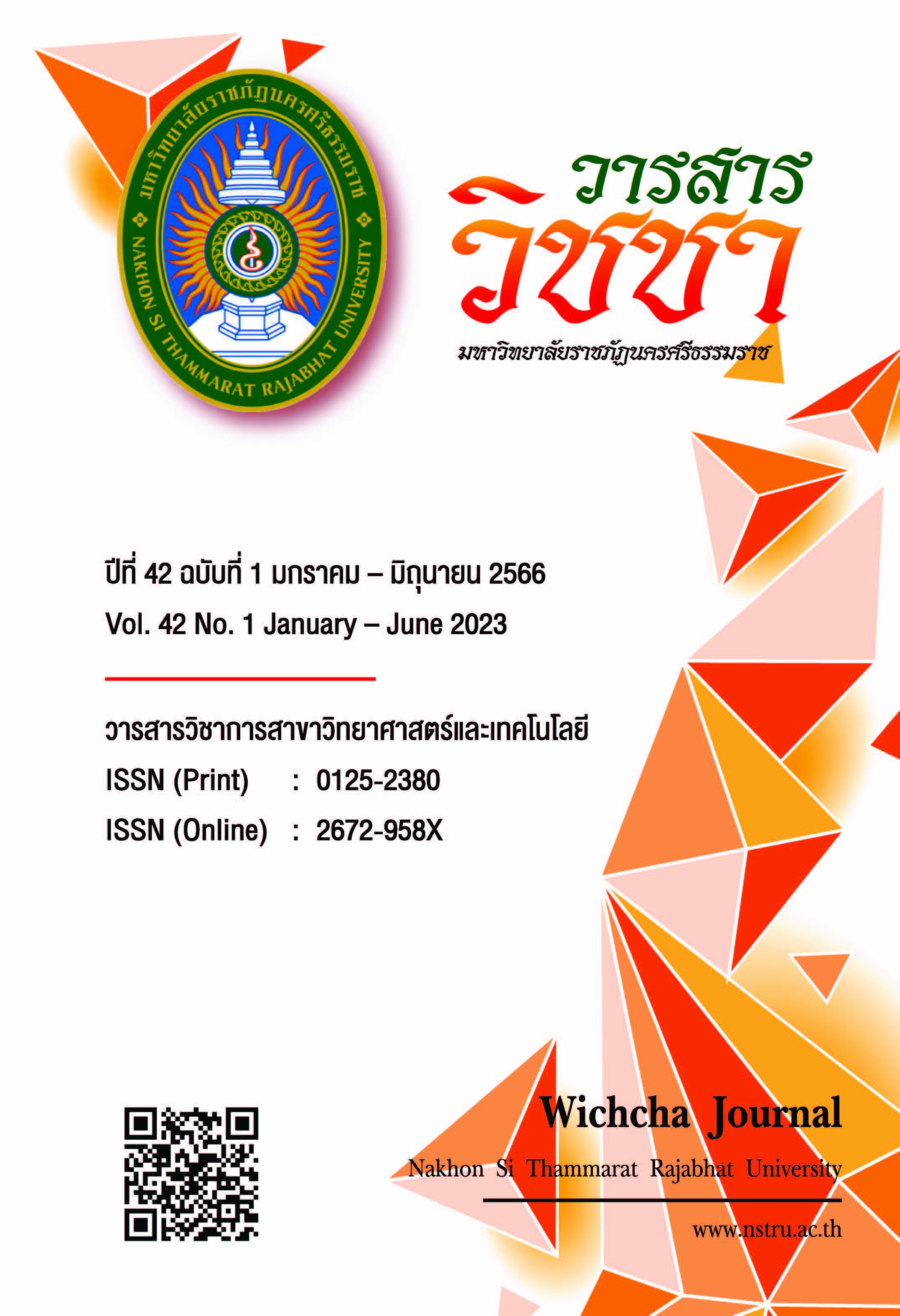The Ability of PM10 Capture on Leaf in 4 Species of the Genus Ocimum L.
Main Article Content
Abstract
Airborne Particulate Matter (PM) that exceeds standard is a severe problem affecting health of the population. Plants have the ability to capture particulate matter in the air; however, leaves with a rough leaf surface structure has higher efficiency in adsorbing the particulate matter than those with a smooth leaf surface structure. The plants in the genus Ocimum, which are the popular home-grown vegetables for Thai people, shows a high ability to adsorb the particulate matter in the air. Their leaves consist of both trichome and gland at the surface which are efficient in capturing particulate matter. Therefore, species of Ocimum, namely Lemon Basil (Ocimum × africanum Lour.), Sweet Basil (O. basilicum L.), Tree Basil (O. gratissimum L.) and Holy Basil (O. tenuiflorum L.) are investigated to study leaf shape, leaf size, trichome and stomata on the capturing efficiency of particulate matter of a diameter less than 10 micrometer (PM10). The results suggested that lemon basil and holy basil had higher abilities to capture PM10 than the other 2 species. The large stomata size and the long trichome of lemon basil resulted in the higher efficiency of PM10 adsorbing ability. There was no difference in volatile oil gland density among the four species of Ocimum. It is worth to note that leaf arrangement, plant habitat and plant canopy are also affected the particulate matter adsorbing ability of the plants.
Article Details

This work is licensed under a Creative Commons Attribution-NonCommercial-NoDerivatives 4.0 International License.
เนื้อหาและข้อมูลในบทความที่ลงตีพิมพ์ในวารสารวิชชา มหาวิทยาลัยราชภัฏนครศรีธรรมราช ถือเป็นข้อคิดเห็นและความรับผิดชอบของผู้เขียนบทความโดยตรง ซึ่งกองบรรณาธิการวารสารไม่จำเป็นต้องเห็นด้วยหรือร่วมรับผิดชอบใด ๆ
บทความ ข้อมูล เนื้อหา รูปภาพ ฯลฯ ที่ได้รับการตีพิมพ์ในวารสารวิชชา มหาวิทยาลัยราชภัฏนครศรีธรรมราช ถือเป็นลิขสิทธ์ของวารสารวิชชา มหาวิทยาลัยราชภัฏนครศรีธรรมราช หากบุคคลหรือหน่วยงานใดต้องการนำข้อมูลทั้งหมดหรือส่วนหนึ่งส่วนใดไปเผยแพร่ต่อหรือเพื่อการกระทำการใด ๆ จะต้องได้รับอนุญาตเป็นลายลักษณ์อักษรจากวารสารวิชชา มหาวิทยาลัยราชภัฏนครศรีธรรมราชก่อนเท่านั้น
The content and information in the article published in Wichcha journal Nakhon Si Thammarat Rajabhat University, It is the opinion and responsibility of the author of the article. The editorial journals do not need to agree. Or share any responsibility.
References
กรมควบคุมมลพิษ. (2561). โครงการศึกษาแหล่งกำเนิดและแนวทางการจัดการฝุ่นละอองขนาดไม่เกิน 2.5 ไมครอน ในพื้นที่กรุงเทพและปริมณฑล. กรุงเทพฯ: กองจัดการคุณภาพอากาศและเสียง กรมควบคุมมลพิษ กระทรวงทรัพยากรธรรมชาติและสิ่งแวดล้อม.
กรมอนามัยและกรมควบคุมโรค กระทรวงสาธารณสุข. (2558). แนวทางการเฝ้าระวังพื้นที่เสี่ยงจากมลพิษทางอากาศ กรณีฝุ่นละอองขนาดเล็ก. กรุงเทพฯ: ชุมนุมสหกรณ์การเกษตรแห่งประเทศไทย.
เตือนใจ ปิยัง กัตตินาฏ สกุลสวัสดิพันธ์ และอเนก สาวะอินทร์. (2561). การศึกษาเถ้าปาล์มน้ำมันเพื่อผลิตแผ่นคอนกรีตปูพื้นทางเท้า. วารสารวิชชา มหาวิทยาลัยราชภัฏนครศรีธรรมราช, 37(1), 81-94.
ธิติมา วงษ์ชีรี. (2551). ความสัมพันธ์ระหว่างความเสียหายของเยื่อหุ้มเซลล์และการเกิดอาการสะท้านหนาวของใบพืชสกุลกะเพรา. วิทยานิพนธ์ปริญญาปรัชญาดุษฎีบัณฑิต (เทคโนโลยีหลังการเก็บเกี่ยว). มหาวิทยาลัยเกษตรศาสตร์, กรุงเทพฯ.
นิพนธ์ ตังคณานุรักษ์ และคณิตา ตังคณานุรักษ์. (2552). เคมีบรรยากาศ. กรุงเทพฯ: มหาวิทยาลัยเกษตรศาสตร์.
บารมี โอสธีรกุล และสัตถาภูมิ ไทยพานิช. (2558). การออกแบบอัลกอริทึมสำหรับการจัดจุดเสียบนพื้นที่ใบพืช. รายงานวิจัย. มหาวิทยาลัยเทคโนโลยีราชมงคลสุวรรณภูมิ.
พาสินี สุนากร องอาจ ถาพรภาษี และพัชริยา บุญกอแก้ว. (2559). การศึกษาเปรียบเทียบความสามารถในการจับฝุ่นละอองของพรรณไม้เลื้อย. สิ่งแวดล้อมสรรค์สร้างวินิจฉัย, 15(2), 175-186.
มัทนภรณ์ ใหม่คามิ และเพ็ญศิริ ไพจิตร. (2564). อิทธิพลของขนและปากใบต่อความสามารถในการดักจับฝุ่น PM10 ของใบไม้พุ่มและใบไม้รอเลื้อยบางชนิด. วารสารวิทยาศาสตร์และเทคโนโลยี มหาวิทยาลัยราชภัฏอุดรธานี, 9(3), 51-65.
ราชันย์ ภู่มา ปิยชาติ ไตรสารศรี จิรพรรณ โสภี นัยนา เทศนา มานพ ผู้พัฒน์ และโสมนัสสา ธนิกกูล. (2563). ต้นไม้ลดฝุ่น PM2.5. กรุงเทพฯ: สำนักวิจัยการอนุรักษ์ป่าไม้และพันธุ์พืช กรมอุทยานแห่งชาติสัตว์ป่าและพันธุ์พืช กระทรวงทรัพยากรธรรมชาติและสิ่งแวดล้อม.
วริศชนม์ นิลนนท์ กุลพร พุทธมี และจิรพร สวัสดิการ. (2560). การพัฒนาการผลิตแป้งฟลาวร์และสตาร์ชจากเมล็ดทุเรียน และการประยุกต์ใช้ในผลิตภัณฑ์อาหาร. รายงานวิจัย. มหาวิทยาลัยราชภัฏรำไพพรรณี.
สุนันทา ข้องสาย. (2563). สภาวะที่เหมาะสมในการเตรียมและความสามารถในการดูดซับของถ่านกัมมันต์ที่ผลิตจากวัสดุเหลือใช้ในการผลิตใบจากมวนยาสูบ. วารสารวิชชา มหาวิทยาลัยราชภัฏนครศรีธรรมราช, 39(1), 46-57.
แอนนา เขียวชอุ่ม. (2550). ชีพลักษณ์ กายวิภาค และความสามารถของใบในการดักจับฝุ่นของไม้ยืนต้นบางชนิดในเขตเมือง. กรุงเทพฯ: มหาวิทยาลัยเกษตรศาสตร์.
Abdulrahaman, A.A. and Oladele, F.A. (2005). Stomata, trichomes and epidermal cells as diagnostic features in six species of genus Ocimum L. (Lamiaceae). Nigerian Journal of Botany, 18, 214-223.
Azzazy, M.F. (2019). Micromorphology of pollen grains, trichomes of sweet basil, Egypt. Advances in Complementary and Alternative medicine, 5(1), 427-433, doi: https://doi.org/10.31031/ACAM.2019.05.000604.
Chowdhury, T., Mandal, A., Roy, S.C. and De Sarker, D. (2017). Diversity of the genus Ocimum (Lamiaceae) through morpho-molecular (RAPD) and chemical (GC-MS) analysis. Journal of Genetic Engineering and Biotechnology, 15(1), 275-286, doi: https://doi.org/10.1016/j.jgeb.2016.12.004.
El-Khatib, A.A., El-Rahman, A.M., and Elsheikh, O.M. (2011). Leaf geometric design of urban trees: Potentiality to capture airborne particle pollutants. Journal of Environmental Studies, 7(1), 49-59, doi: https://doi.org/10.21608/JESJ.2011.189119.
Esposito, F., Memoli, V., Panico, S.C., Di Natale, G., Trifuoggi, M., Giarra, A., and Maisto, G. (2020). Leaf traits of Quercus ilex L. affect particulate matter accumulation. Urban Forestry and Urban Greening, 54, doi: https://doi.org/10.1016/j.ufug.2020.126780.
Kwak, M.J., Lee, J.K., Park, S., Kim, H., Lim, Y.J., Lee, K.A., Son, J., Oh, C.Y., Kim, I. and Woo, S.Y. (2020). Surface-based analysis of leaf microstructures for adsorbing and retaining capability of airborne particulate matter in ten woody species. Forests, 11(9), 1-20, doi: https://doi.org/10.3390/f11090946.
Leonard, R.J., McArthur, C. and Hochuli, D.F. (2016). Particulate matter deposition on roadside plants and the importance of leaf trait combinations. Urban Forestry and Urban Greening, 20, 249-253, doi: https://doi.org/10.1016/j.ufug.2016.09.008.
Li, Y., Wang, S. and Chen, Q. (2019). Potential of thirteen urban greening plants to capture particulate matter on leaf surfaces across three levels of ambient atmospheric pollution. International Journal Environmental Research and Public Health, 16(3), 1-12, doi: https://doi.org/10.3390/ijerph16030402.
Nowak, D.J., Crane, D.E., and Stevens, J.C. (2006). Air pollution removal by urban trees and shrubs in the United States. Urban Forestry and Urban Greening, 4(3-4), 115-123, doi: https://doi.org/10.1016/j.ufug.2006.01.007.
Ogunkunle, C.O., Abdulrahaman, A.A., and Fatoba, P.O. (2013). Influence of cement dust pollution on leaf epidermal features of Pennisetum purpureum and Sida acuta. Environmental and Experimental Biology, 11(1), 73-79.
Ram, S.S., Majumder, S., Chaudhuri, P., Chanda, S., Santra, S.C., Maiti, P.K., Sudarshan, M. and Chakraborty, A. (2014). Plant canopies: Bio-monitor and trap for re-suspended dust particulates contaminated with heavy metals. Mitigation and Adaptation Strategies for Global Change, 19(5), 499-508, doi: https://doi.org/10.1007/s11027-012-9445-8.
Sæbø, A., Popek, R., Nawrot, B., Hanslin, H.M., Gawronska, H., and Gawronski, S.W. (2012). Plant species differences in particulate matter accumulation on leaf surfaces. Science of the Total Environment, 427-428, 347-354, doi: https://doi.org/10.1016/j.scitotenv.2012.03.084.
Sanoj, E. and Deepa, P. (2021). Micromorphological variations of trichomes in the genus Ocimum L. Plant Science Today, 8(3), 429-436, doi: https://doi.org/10.14719/pst.2021.8.3.1006.


